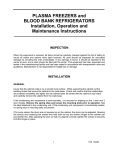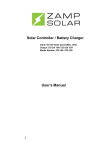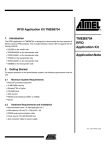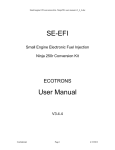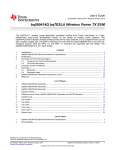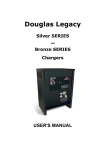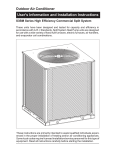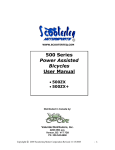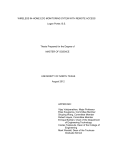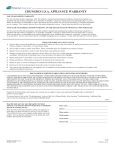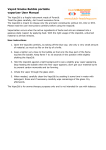Download GENERAL LABORATORY REFRIGERATORS AND - Nor
Transcript
GENERAL LABORATORY REFRIGERATORS AND FREEZERS Installation, Operation and Maintenance Instructions INSPECTION When the equipment is received, all items should be carefully checked against the bill of lading to insure all crates and cartons have been received. All units should be inspected for concealed damage by uncrating the units immediately. If any damage is found, it should be reported to the carrier at once, and a claim should be filed with the carrier. This equipment has been inspected and tested in the manufacturing facility and has been crated in accordance with transportation rules and guidelines. Manufacturer is not responsible for freight loss or damage. INSTALLATION GENERAL After the unit crate and crate base have been removed, locate the casters or legs found inside the cabinet. Attach the casters or legs to the unit base by screwing them into the same threaded fittings that were used to secure the crate base to the cabinet. Insure that the legs or casters are screwed completely into the base. If for some reason the doors are not squared up on the cabinet, the doors can be adjusted. Opening the door(s) and loosening the screws that hold both the top and bottom hinges to the cabinet can accomplish this. After adjusting the door so that it is aligned correctly, tighten the screws to securely hold the hinges in place. VAPORIZER INSTALLATION The General Laboratory forced air models require the installation of the condensate vaporizer, which is shipped inside the unit compartment. The vaporizer should be mounted to the cabinet bottom. Reference View 1. In lieu of the vaporizer, these units can be plumbed to a floor drain following local plumbing codes. The cold wall units do not use a vaporizer. Customer installation is not required. 1 4/06 119503 Note: Disconnect installation. power prior to 1. Connect the power cord to the vaporizer and place it in the vaporizer bracket. 2. Attach the vaporizer bracket to the back of the unit using the four screws as shown, making sure the plastic drain tube is in the vaporizer pan. QuickTime™ and a Photo - JPEG decompressor are needed to see this picture. LOCATION The refrigeration system located at the top of the cabinet requires free air access for proper operation. Allow a minimum four-inch clearance on the top, rear, and sides of the cabinet. The cabinet should also be leveled when it is placed in its permanent location. View 1 ELECTRICAL Check the proposed outlet to be used to insure that the voltage, phase, and current carrying capacity of the circuit from the electrical panel correspond to the requirements of the cabinet. Never use an extension cord to wire any unit. On permanently connected units, those not furnished with a plug-in service cord, all inter-wiring between the electrical panel and the unit must be done in accordance with the National Electric Code and all state and local codes. Refer to the serial tag for all pertinent electrical information. Observe all Warning Labels. Disconnect power supply to eliminate injury from electrical shock or moving parts when servicing equipment. GENERAL OPERATION FORCED AIR UNITS The General Laboratory forced air cabinets employ a unit cooler evaporator located inside the cabinet as the heat-removing source. Through the refrigeration process, heat is captured in the evaporator, transferred to the condensing unit on top of the cabinet, and expelled to the surrounding outside air. It is extremely important to allow a four-inch clearance on the top, rear, and sides of the unit for the refrigeration process to function properly. Cold control adjustment To increase or decrease the internal cabinet temperature, rotate the cold control, located on the unit cooler, to the desired temperature. 2 4/06 119503 Refrigerators During the operation of refrigerator units, frost will periodically form on the coil surface. Each time the compressor cycles "off", the evaporator fans will continue to run, which will keep the internal temperature uniform and at the same time remove any frost build up on the coil. The water produced will collect in the unit cooler drain pan and travel down the drain tube to the condensate vaporizer. Freezers After shutting the door on freezer models, a short amount of time must be allowed before the door can be reopened. This is due to the tight seal maintained between the door and the cabinet. Waiting a few moments for the pressure to equalize permits the door to be opened easily. A positive defrost is required to remove frost from the coil in freezer models. This is accomplished by energizing heaters during the defrost cycle that are QuickTime™ and a positioned on the coil surface. The time clock is Photo - JPEG decompressor factory set to allow four defrosts per day. Note: are needed to see this picture. Adjustment of the correct time of day will be required to maintain these defrost periods. As the preset defrost time is reached, the time clock automatically terminates the refrigeration process by turning off the condensing unit and unit cooler fan motors, and energizes the defrost heaters. As the coil temperature increases, the frost begins to melt producing water that runs down the coil to the unit cooler drain pan and exits through the drain tube to the vaporizer. After all the frost has been removed and the coil temperature reaches approximately 50°F, the defrost is terminated through the action of the defrost termination control located on the unit cooler, and the refrigeration process resumes. In order to insure that any excess water remaining on the coil is not sprayed into the cabinet interior, and all heat generated by the defrost is removed, the unit cooler fans will not operate until the coil1 temperature reaches Figure approximately 25°F. Time clock adjustments (Freezers) Setting the correct time of day: To set the correct time of day simply rotate the small inner dial counterclockwise until the correct time of day on the large dial is opposite the "time" indicator. In referring to Figure 1, the correct time of day shown is 7:30 a.m. Number of defrosts per day: The timer is factory set to defrost the evaporator four times a day. If more defrosts are required, remove a knurled slotted screw from the holder, insert the screw into the time slot on the large dial where a defrost is desired, and tighten. Insure that an equal time exists between each defrost pin. Defrost length adjustment: On the small, upper dial there is a pointer that is used to set a 100% fail-safe feature. The fail-safe of the timer, refer to Figure 1, is factory set at 30 minutes. With this feature, the defrost will terminate if a system malfunction occurs during defrost. No adjustment of this device should ever be necessary. Lengthening the fail-safe time will not lengthen the defrost cycle. 3 4/06 119503 Figure 1 shows the time switch set to defrost at 2:00 a.m., 8:00 a.m., 2:00 p.m., and at 8:00 p.m. The fail-safe pointer indicates that the system will revert to cooling thirty minutes after a normal defrost cycle began should a malfunction occur. WARNING: The fail-safe feature is a safety mechanism and should never be used to control the length of the defrost period. This feature is provided to protect the contents of the freezer from damage should the system fail to revert to the cooling cycle because of mechanical difficulties. Note: The time switch shown in the illustration is factory set to provide four defrosts per day. This setting should provide adequate defrosting for even the most heavily used system. If experience shows that the four set defrost periods are more than necessary, one or more of the knurled setscrews may be removed. AT LEAST ONE OF THE KNURLED SET SCREWS MUST BE LOCATED ON THE LARGE LOWER DIAL AT ALL TIMES. COLD WALL UNITS The cold wall models employ evaporator tubing embedded in the sidewalls, back, and top of the unit. During the refrigeration process, heat is removed through the evaporator tubing and expelled through the condensing unit. Because of the cold wall design, it will be necessary to occasionally manually defrost the freezer models. To do this, unplug the unit and open the door. Wipe the cabinet dry when defrosting is complete. With cold wall refrigerators, condensation may form on the interior of the cabinet and should be periodically wiped dry. Cold Control Adjustment The temperature control knob is located on the top of the cabinet behind the facade. To make a small increase or decrease in the internal cabinet temperature, rotate the control knob as needed. Enzyme Freezer Only The Enzyme Freezer is equipped with a programmable controller to control the settings. The controller, which is located on the facade of the unit, is factory set. Please see the separate instructions that are included on the operation of this controller. GENERAL MAINTENANCE PERIODIC CLEANING Beginning with the initial installation, the interior surfaces of the cabinet should be periodically wiped down with a solution of warm water and baking soda. This solution will remove any odors from spillage that has occurred. The exterior of the cabinet should also be cleaned frequently with a commercial grade of glass cleaner. Caution: Never use an abrasive or alkaline solution to clean these units. Wipe dry after cleaning. Important: Monthly cleaning of the condenser coil located on top of the cabinet should be done. This cleaning will aid the heat transfer characteristics of the refrigeration system and increase its efficiency. Dust, dirt, and lint will tend to accumulate on the fins of the condensing unit. This obstruction will affect the flow of air through the condenser, thereby lowering the efficiency of the system. A wire brush or a brush with stiff bristles can be used to loosen these particles that are attached to the fins so that they may be removed with a vacuum cleaner. Failure to keep the condenser coil clean and clear of obstructions could result in temperature loss and damage to the compressor. 4 4/06 119503 All moving parts have been permanently lubricated and will generally require no maintenance. MAINTENANCE SERVICE AND ANALYSIS GUIDE REFRIGERATION SYSTEMS - ALL MODELS MALFUNCTION POSSIBLE CAUSE SOLUTION Compressor will not start no hum 1. 2. 3. 4. 5. Service cord unplugged Fuse blown or removed Overload tripped Control stuck open Wiring incorrect 1. 2. 3. 4. 5. Plug in service cord Replace fuse Determine reasons and correct Repair or replace Check wiring against the diagram Compressor will not start hums but trips on overload protector 1. 2. 3. 4. Improperly wired Low voltage to unit Starting capacitor defective Relay failing to close 1. 2. 3. 4. Check wiring against the diagram Determine reason and correct Determine reason and replace Determine reason, correct or replace Compressor starts and runs, but short cycles on overload protector 1. Low voltage to unit 2. Overload defective 3. Excessive head pressure 4. Compressor hot-return gas hot Compressor operates long or continuously Short of refrigerant Control contact stuck Evaporator coil iced Restriction in refrigeration system 5. Dirty condenser 1. 2. 3. 4. Compressor runs fine, but short cycles 1. 2. 3. 4. 5. 1. 2. 3. 4. 5. Starting capacitor open, shorted or blown 1. Relay contacts stuck 2. Low voltage to unit 3. Improper relay 1. Clean contacts or replace relay 2. Determine reason and correct 3. Replace Relay defective or burned out 1. Incorrect relay 2. Voltage too high or too low 1. Check and replace 2. Determine reason and correct Refrigerated space too warm 1. 2. 3. 4. 5. 6. 1. 2. 3. 4. 5. 6. Standard temperature system freezes the product 1. Control setting is too low 2. Control points stuck 1. Reset the control 2. Replace the control Objectionable noise 1. 2. 3. 4. 5. 1. 2. 3. 4. 5. Pan Area 1. 2. 3. 4. 1. Determine reason and correct 2. Check current, replace overload protector 3. Check ventilation or restriction in refrigeration system 4. Check refrigerant charge, fix leak if necessary Overload protector Cold control Overcharge Air in system Undercharge Control setting too high Refrigerant overcharge Dirty condenser Evaporator coil iced Not operating Air flow to condenser or evaporator blocked Fan blade hitting fan shroud Tubing rattle Vibrating fan blade Condenser fan motor rattles General vibration Fix leak, add refrigerant Repair or replace Determine cause, defrost manually Determine location and remove restriction 5. Clean condenser Check wiring diagram Differential too close - widen Reduce charge Purge and recharge Fix leak, add refrigerant Reset control Purge refrigerant Clean condenser Determine reason and defrost Determine reason, replace if necessary Remove obstruction for free air flow 6. Worn fan motor bearings Reform or cut away small section of shroud Locate and reform Replace fan blade Check motor bracket mounting, tighten Compressor suspension bolts not loosened on applicable models - loosen them 6. Replace fan motor 1. No cooling 2. Too cold 1. Make sure switch is in the "on" position 2. Adjust temperature control - see instructions 5 4/06 119503 under pan area 3. Adjust temperature control - see instructions under pan area 3. Too warm 6 4/06 119503






